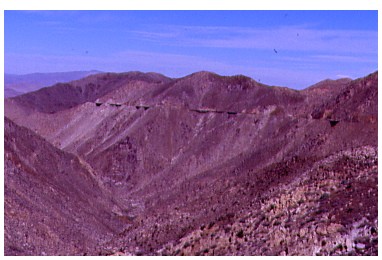
Once upon a time a railroad was built east from San Diego to Seeley{El Centro} as the San Diego & Arizona which was known as The Impossible Railroad which was completed on November 15, 1919. It ran from San Diego south to the border with Mexico at San Ysidro, crossed into Mexico through Tijuana to Tecate. Northeast of Tecate the railroad crossed back into the United States to Campo. East of Campo it ran through clover Flats then across the high 600 foot long Upper Campo Creek Viaduct. It crossed the Coast Range at Hipass at an elevation of 3,660 feet. The line then headed down the grade to Jacumba and Dubbers. From Hipass to the desert floor 3440 feet down, the railroad builders faced their greatest challenge, the Carriso Gorge, in order to complete the line. So the railroad could keep it 2.2 gradient and keep the curvature down the need for extensive tunnels and trestle work was needed to build the line. The line was built to a 2.2 grade and hung on a ledge 1,000 feet above the normally dry stream. The 17 tunnels in the Carriso Gorge have a total length if combined of 13,385 feet. The whole 11 miles through the Carriso Gorge cost $4 million dollars in 1919. Some of the final cost of building the San Diego & Arizona came from the 21 tunnels which covered almost three miles of the line at $1.8 million. There was nearly 2.5 miles of bridgework on the line. Total per mile cost came to $129,000 which would be very high for building a railroad in those days.
The railroad struggled on in it's early days facing avalanches blocking Tunnel 7 on May 10th, 1920, border closings with Mexico in 1929 and a tunnel fire at Tunnel 3 in Mexico in January 1932. Damage for rainstorms came in 1926, 1927 and 1929. On March 27,1929 a slide blocked Tunnel 15. The company had enough of problems with Tunnel 15, eliminated part of it and built the 636 foot, 185 foot high wood-pile Goat Creek Trestle. The trestle was made out of wood because steel would have expanded and contracts in the extreme temperatures of the Carriso Gorge from below freezing in the winter to the over 110+ degrees temperatures in the summer. Months later on October 22, 1929 Tunnel 7 burned and this time was bypassed by a seven degree curves. On October 24,1932 the Southern Pacific Railroad gained control of the railroad changing it's name to the San Diego & Arizona Eastern. The last passenger train run took place on January 11,1951. The SP ran the line with little problems until 1951 when washouts and a floods near Tunnel 8 and 10 shut down the line once more until repairs could be made. Things returned back to normal with no more major operating problems until September 10,1976 when the final major disaster hit the San Diego & Arizona Eastern Railroad, Tropical Storm Kathleen, wiped out the line in the desert. Three trestles were completely destroyed and five others damaged as well as 50 washouts and slides. The SP announced that it would cost $1.27 million dollars to repair the line.
The SP wasn't about to go out and repair the railroad with a long history of problems with little profit if any to be made. The SP would be willing to sell the line off if a buyer would come for it. The San Diego Metropolitan Transit Board wanted the SD&AE right a way in San Diego County for its future light rail lines to be built. Tropical Storm Kathleen had done the SDMTB a favor making the whole SD&AE available. A price of $18.1 million with the SP agreeing to restore the line to service. In 1979-1980 Tijuana suffered it's worst flooding ever damaging the railroad once again in Mexico and was restored again. The rail were restored through the Carriso Gorge in 1980 and through service was again provided. Kyle Railways operated the railroad as the San Diego & Arizona Eastern until 1984. The line was again shut down when a fire closed the line at Tunnel 6 in the Carrizo Gorge and it looked like it might never be repaired as the years continued to roll by on the calender. In March 1984 the SDMTB signed an agreement with Rail Tex to operate the line as the San Diego & Imperial Valley. and started service on October 15,1984. Rail Tex was then acquired by Rail America on January 4th,2000. The Mexican segment was subcontracted out to the Carrizo Gorge Railroad on July 1,2001 after a failed short line privatization of the Tijuana and Tecate which was acquired by the state government of Baja California Norte. In February 2002, the CZRY got permission to operate into Campo from Mexico and beyond east.
The Carrizo Gorge Railroad had a goal in mind when they started to operate trains on this historic railroad. They wanted to reopen the line through the Carrizo Gorge to through freight train service. They started with Tunnel 2 and 3 in Mexico returning them to service in 2001. Since 1983 in the Carrizo Gorge the trestle at MP 97.94 had a left side cave in and Tunnel 6 had collapsed. Tunnel 8 had major problems due to a landslide and Tunnel 14 had an obstruction inside of it. The Goat Creek Trestle, the world's largest wooden trestle, had been a victim of vandalism mostly by paramilitary types dropping rocks onto the wooden supports below it. Tunnel 16 had over 100 feet of debris inside of it from cave ins over the years since trains operated. Add into boulders that had come down onto the tracks over the years plus the wildfire and other acts of vandalism the work crews had a major repair job in front of them to get the line back in service. The started to the work slowly making they way into the Carrizo Gorge. Tunnel 8 was finally repaired in September of 2003 and with all other work completed that left only Tunnel 16 to be finished. it looked like it would be done by the end of December 2003. Once that gets done and after a few test trains would be run through the Carrizo Gorge, freight service would be started again after an over 20 year period of time in the first quarter of 2004 if all goes right.
Now let's get to my history with this historic rail line. It started with me buying the book "San Diego & Arizona - the Impossible Railroad by Robert M. Hanft which is where I attained some of the material in the part story above. I saw the great pictures and read the text which made me want to ride this railroad someday. My riding started on the San Diego Railroad Museum at Campo on their train ride east to Miller Creek in 1983. Next was the trip from Campo to San Diego via Tecate and Tijuana on March 30th,1984. It got sober on January 18th 1995 and to prove to myself and to my parents that I could ride a train in Mexico sober I rode a San Ysidro to Tecate Excursion Train on February 24th,1996. A Trip later that year to Campo provided a steam train ride to Miller Creek behind ex Southern Pacific 4-6-0 2353 on September 21st,1996. My next trip on the railroad on April 26th,1997 was on the Jacumba and Beyond Excursion which took us east of Miller Creek, over the Upper Campo Creek Viaduct to a point near Dubbers near the entrance to the Carrizo Gorge. All of these trips are on my train riding story page on my web site. Just click on home at the bottom to access those stories. I had ridden this far the San Diego & Arizona Railroad but I knew it would take something truly special to happen so that I could ride into the Carrizo Gorge. The name of that special thing was the Carrizo Gorge Railroad.
It all started with Altamont Press' "Railroadnews.net" posting a story on the November 17th, 2003 that ran in the Imperial Valley News called "Tour underscores tenacity needed to complete link". In that article they mentioned more trips to be run in the future. Richard Elgenson, a very good friend and fellow Trainweb reporter, called the Carrizo Gorge Railroad speaking with Geoffrey Shuerman who invited Richard and I aboard a special train to be run from Jacumba to Tunnel Number 16 on December 6th,2003. Planning then started for this very special trip. Richard took care of the hotel and we were set to leave on December 5th.
Heading for Jacumba12/05/03Richard picked me up and we were on the highway by 3:00 PM driving south towards the San Diego area. We hit San Diego rush hour traffic first on the southbound Interstate 5 near Del Mar which took us onto Interstate 805 which wasn't any better. We headed east on California 52 which was another slow go. It finally broke lose and we turned south on CA 126 which was fine until it was time to get onto the on ramp for the transition to Interstate 8 where we ground to a stop and go situation. We decided to find the In and Out in El Cajon for dinner and enjoyed our meals plus the time out of the traffic. Traffic was much better as we traveled I 8 east the remaining 14 miles to Alpine where we stayed the night at the very rustic Country Inn.
12/06/03After an excellent rest at the Country Inn, we headed east once more with Richard putting on U2's Beautiful Day the perfect song for this most wonderful day of my life. We went down Interstate 8 to Boulevard where we turned off onto CA 94 which took us east to Jacumba. We turned north onto Railroad Street crossed the dry Boundary Creek before pulling into a parking area behind the still standing SD&A Depot. Here I shot many pictures of things on the Carrizo Gorge Railroad's property including the two ex Spirit of Washington F-units the railroad acquired.
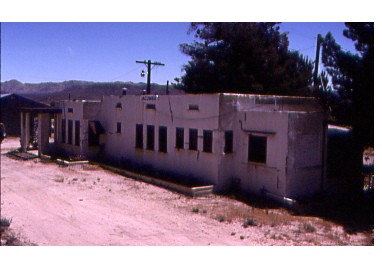
With all the picture that I needed to take in Jacumba, we boarded the ex Amtrak 44 seat coach 5601 built in 1939 for the Atlantic Coast Line as 201 later becoming the Seaboard Coast Line 5601. Our trips power would be the GP-9 5911, the ex San Diego & Imperial Valley 5911, ex Kyle Railways 5921 and ex DRGW 5921. The coach was filled with all seats taken and a few standees for this most special trip we all would be taking this morning.
The Trip into the Carrizo Gorge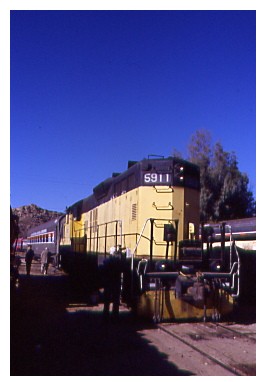
Our special train left Jacumba at 9:05 AM with everyone onboard with a sense of excitement to the views we would be seeing in just a few more minutes. The conductor asked if anyone had any questions before talking about the Goat Creek Trestle. The train ran along at a nice slow pace giving everyone in the cars great views through the large windows. The train rounded a hill before passing Titus siding which was filled with ballast cars. We crossed Boundary Creek, passed by Round Mountain to the west before ducking under the Interstate 8 bridge and passing the De Anza Springs Campground where we came on the Jacumba and Beyond trip. I ventured into the vestibule finding a TV interview taking place and took the left hand vestibule window for the future Carrizo Gorge pictures as I started on my new mileage. The train crossed Carriso Creek on a 316 foot low wooden trestle as the land started to get more rocky in nature. Large boulders could now be seen so I knew we were getting close to the start of the Carrizo Gorge. Our train crossed another couple of trestles the second one at 135 feet before we reached the Dubbers Spur where maintenance of way equipment was on hand. At MP96.11 we crossed the 178 foot trestle and a minute later entered our first tunnel of the morning, the 398.6 foot long Tunnel 5 with my anticipation of entering the Carrizo Gorge at an all time high.
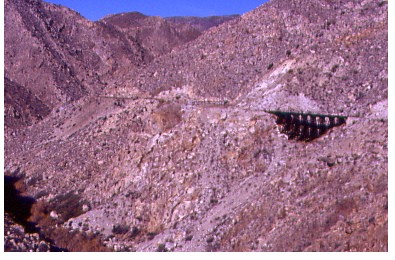
We exited out of Tunnel 5 finding where Carriso Creek net Walker Canyon from the west. The valley we had been riding in suddenly starts to become the Carrizo Gorge as the stream bed has eroded down through the years into the start of this great chasm we have entered. As the Gorge's walls steepens the rails are now on a ledge cut out along the rock wall and in places four trestles are required to make the route possible. The third one has several grates missing and the fourth one has it's left side partially caved in. Next we entered Tunnel 6, a 382.4 foot affair then the tracks snaked high above the gorge before the train crossed to more short trestle a 90 foot long version and a shorter one. We came to a stop for a photo opportunity on the ground for all passengers. This location has one a the greatest views inside the whole Carrizo Gorge.
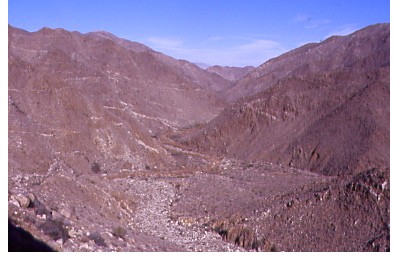
While a vestibule is good for pictures having to share it meant I might miss something. I asked Geoffrey Shuerman if it would be possible to ride out on the engine's walkway thus allowing ease in picture taking. He said this was what he wanted all the press to do so I headed to the gorge side of the engine and minutes later Richard found me before we were off again on this great rail adventure. Standing there, looking out and down into the Carrizo Gorge, it was true that I was really living out one of my all time railroad dreams.
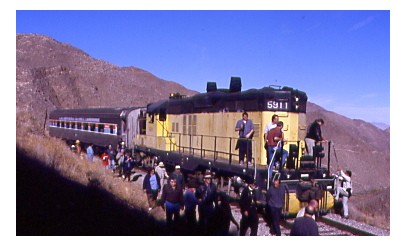
What a much better view I now had as the train started moving again. It was now easier to look up, across and down into the Carrizo Gorge. We passed the location of Tunnel 7 which collapsed on October 22,1932 as the train went around the rocky point high above the Carrizo Gorge. Down below there is the remains of the Coors Box Car that we over the edge in 1953. There is also a remains of a construction camp located far below the tracks on one of the few level area in the gorge. That led us up to the 2527 foot long Tunnel 8. This is one tunnel that they reopened with the south entrance using gunite, a concrete mixture under pressure over steel reinforcements, that has stabilized the tunnel. Talk about one long tunnel and it's a dusty world inside the tunnel's darkness. Of course the engine's headlights and ditch light shows the way to the northern exit. To the right of the northern entrance of tunnel 8 up above the tracks there is a spring. We crossed the 15 foot trestle as we made our way to Tunnels 9 and 10 which are in line. Tunnel 9 is 600 feet long while Tunnel 10 is 925 feet long. Our train snaked it way to Tunnel 11 which is 381 feet long. Beyond this tunnel is the Carriso Gorge siding which is only 863 feet long but in the only place in the gorge so far that a siding could be built.
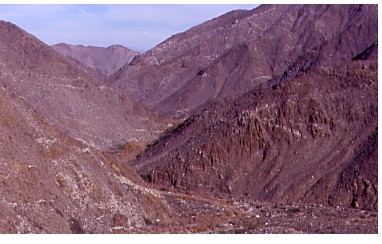
The view from here is spectacular as well. While the views are ever changing, the whole Carrizo Gorge is one of the most spectacular places I have ever visited by rail in North America. Near the northern of the siding our train entered the 342 foot long Tunnel 12. That was followed by passing through Tunnel 13 with a length of 299 feet. A few more curves with fabulous views, took us to Tunnel 14 which is the longest tunnel we would pass through today with a length of 2597 feet. We continued to curve along our ledge to the former location of Tunnel 15 which collapsed on March 27th,1932. This tunnel closure was the one that led to the construction of the Goat Creek Trestle. We passed through the 177.7 foot long Tunnel 15A then came to a stop just short of the Goat Creek Trestle.
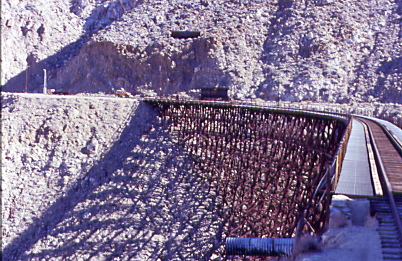
Here it was announced that all press members could walk across the Goat Creek Trestle in order to get a picture of our train crossing the trestle. Richard and I detrained with us starting our walk over this 185 tall and 633 foot long wood-pile trestle. I must admit this was far more interesting than crossing that swinging bridge on the Idaho Northern and Pacific trip but this one is so much higher with a far superior view. It was a differently a highlight of my train riding career. Everyone who got off went to the shady side of the trestle while Richard followed me down the tunnel spur to the end then continued to a point that got almost to a ninety degree angle to the Goat Creek Trestle. Off to the left on the slope is the remains of the tunnel 15 portal on about a 15 degree angle. With the bridge now in front of us, what a scene!
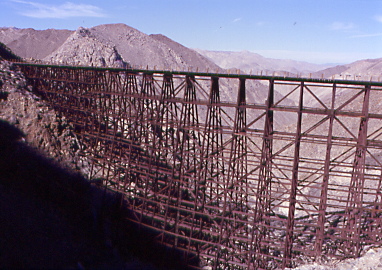
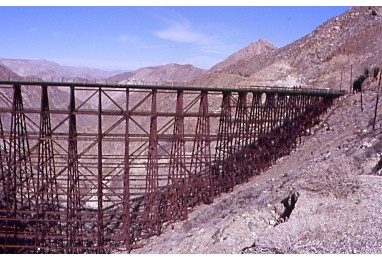
This is most extensive wooden bridge that I have ever seen. It looks impressive in pictures but seeing it for real is really something. Looking through the piles you can see into the gorge. After a few more minutes, our train slowly rolled out onto the Goat Creek Trestle.
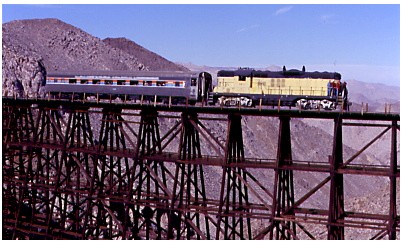
Following the clicking off of all those pictures we walked back over to the train now stopped beyond the Tunnel Spur. I walked over to the west for a few more pictures of the Goat Creek Trestle.
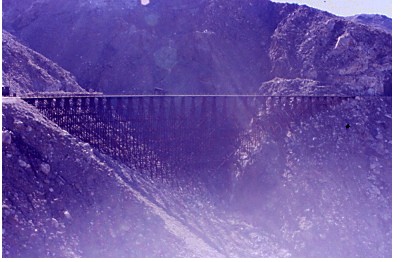
During the hour we spent at the Goat Creek Trestle, I had the chance once a San Diego Union Tribune reporter I talked with Carrizo Gorge Railway President Gary Sweetwood. As listened to the interview prior to talking to Gary, I learned US Representative Bob Filner, Democrat San Diego had secured 10 million dollars to use on restoring this rail line. Once they get the line open, the railroad expects to take care of all the small stuff that will still need to be done. This includes cosmetic stuff and upgrades to the rail line. Some of the rail is 75 pounds laid back in 1917 when the line was built needs to be replaced to today's standard of 115 ponds to be able to handle the modern freight cars that will be used on the railroad in the very near future. future traffic bases were also discussed and the railroad should be successful if it lands this traffic. The first two are propone gas as well as sand and gravel. I enjoyed my visit with Gary before Richard had a nice talk with him. I climbed back up onto the engine and photographed Richard and Gary speaking together.
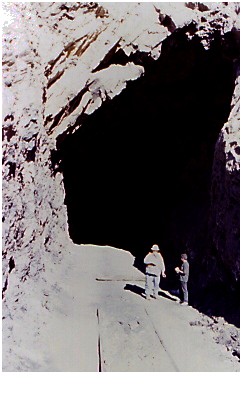
A few minutes later after an all aboard and a toot of the horn, Richard joined me again up on the engine as we started to head back to Jacumba. I was on then corner near the steps so I could shot pictures forward, sideways, up or down plus from there behind. I choose this spot so I could capture all the tunnel portals on film plus the fading views on our return. Our engine 5921 was now pushing our coach 5601 back to Jacumba. We went passed the Tunnel Spur then out onto the Goat Creek Trestle this time with me riding the train. My perch gave me a great panoramic view of the trestle. What an experience! The train entered Tunnel 15A and as we curved inside this tunnel my view of the Goat Creek Trestle disappeared.
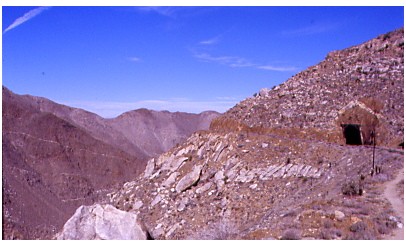
While I was focused on the Carrizo Gorge on the way out, I now found myself looking at the rocks, gorge walls and the vegetation. The various type of cactus found in the gorge are amazing. I didn't spot any Big Horn Sheep on this trip but Gary said the sheep came down to the construction activity to take a look at what was going on. As we entered each tunnel I tried to get a entering view as well as an exiting picture. With the sun in a different location in the sky, the lighting in the Carrizo Gorge was slightly different than our trip out. Looking towards the sun, the shadows were less pronounced. I was really enjoying myself. What an incredible journey I was on this great day of my life!
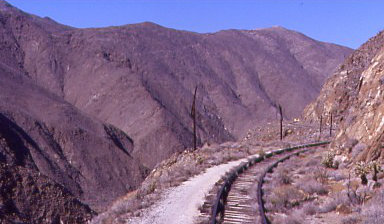
The trip back seemed a lot quicker and as we neared the upper reaches of the Carrizo Gorge I began to feel sad that this trip was coming to an end. then it hit me that what an incredible experience I had just lived. Dreams to come true, and in my railroad life this was a major one. I was sure glad that Richard had made that phone call and thought about asking me to come here. To Richard of Lets Talk Trains that let me reschedule my appearance from today to next Saturday December 13th. The biggest thanks goes to the Carrizo Gorge Railway for having here representing Trainweb. This was an spectacular trip and one I will never forget. We exited the Carrizo Gorge and returned to Jacumba at 12:50 PM.
The Trip HomeOnce we arrived back in Jacumba, I photographed the power, the train and the equipment laying around the yard. I walked down to the three former SP wooden car bodies open vestibule coaches that had been used as track side residents by maintenance workers. They are truckless and in very poor shape.
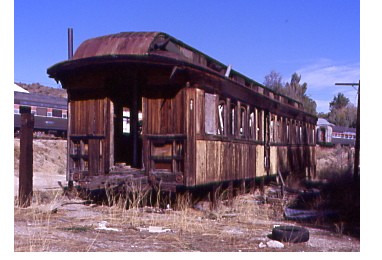
Richard and I drove back to Santa Ana stopping only for gasoline in Oceanside. This return home brought to an end one of the most unusual and unique rail adventures that I had ever taken into the Carrizo Gorge.